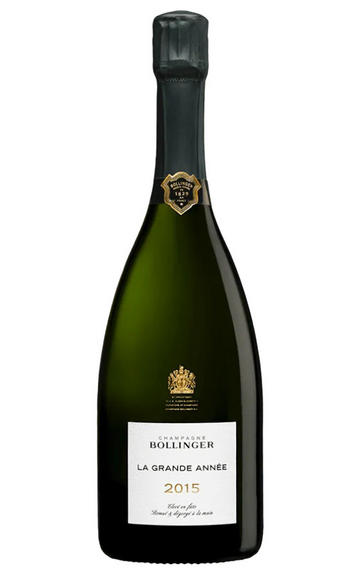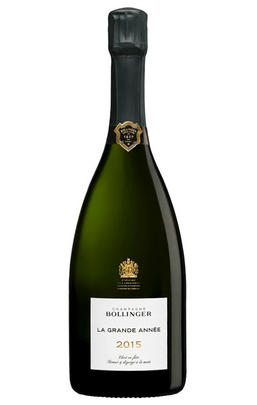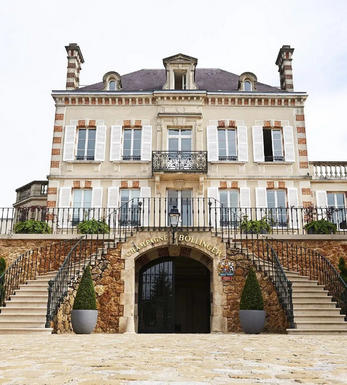
2015 Champagne Bollinger, La Grande Année, Brut

Critics reviews
Bollinger's 2015 Brut Grand Année is an intriguing wine in that is clearly reflects the decision to pick on the later side in order to avoid vegetal notes derived from the mismatch of alcoholic and phenolic ripeness.
"Balance was hard to achieve in 2015," Chef de Cave Dennis Bunner notes. "At 10% in sugar, the fruit was simply not ripe. We had to wait to reach the optimal window of ripeness." Bunner also opted to increase the Chardonnay, so the blend is 60% Pinot Noir and 40% Chardonnay, as opposed to the more typical 70/30 blend, with more Verzenay than Aÿ in the Pinots.
Dried citrus peel, sage, menthol, sage, tangerine peel and spice build with some coaxing. Light tropical overtones develop with aeration. There's real density and textural richness here. This will be a fascinating vintage to follow. Stylistically, it is the complete opposite from the much more linear 2014 that precedes it. Dosage is 8 grams per liter. Disgorged: May 2023.
Drink 2028 - 2040
Antonio Galloni, Vinous.com (March 2024)
60% Pinot Noir and 40% Chardonnay from the Montagne de Reims, Grande Vallée de la Marne and Côte des Blancs, all fermented in small oak barrels and disgorged in May 2023 after seven years on lees.
A forward vintage for La Grande Année, with warmth evident in its roasted orange, Comice pear and Mirabelle plum, all polished with a sense of savoury maturity that is very Bollinger at heart. There’s a little more oxygen influence seemingly at play than in the 2014, with brine, nuts and a little dried leaf character already taking this far beyond fruit. The food-friendly chewiness of 2015 is there, but the mousse is supple and the Chardonnay brings the wine to a close with a fine, cooked lemon snap. This will start to show its best integration from 2025 onwards, although it is open for business now.
Drink 2025 - 2034
Tom Hewson, Decanter.com (March 2024)
The color is already deep golden with a fine stream of tiny bubbles fighting their way up through the glycerol-rich concentrated wine. Intense and rich and at the same time nuanced and complex. The small concentrated grapes ultimately produced an ultimate gastronomic masterpiece.
The scent cannonade is classic Bollinger, but fresh and more nuanced than I expected from the vintage. Stone fruits, honeysuckle, honey, plum marmalade, Cox Orange, raspberry, almond, hazelnut, leather, tanned skin, cigar, and duck liver are all clear instruments in the orchestra playing their richly generous vintage anthem. The freshness does not come from acid this time, but from lack of water and concentrated extracts in a similar way as the even more extreme 2003.
I finish I find tobacco, forest and chocolate with sea salt, a delicious combination. Precisely the saltiness and the slightly higher tannin content contribute to making this a perfect partner for poultry in all its forms.
Richard Juhlin, The Champagne Club (March 2024)
A hot year with drought issues made Bollinger seek freshness and subtlety via Pinot Noirs of north facing terroirs and an unusually high proportion of Chardonnay (40%). The nose oozes lush red berry fruit, golden raisins and tropical fruit exuberance. Rich and ripe in profile, the wine if laudably free of the culprit of the year, the vegetal austerity, which Bollinger was able to avoid by barrel vinifications’ effect in removing excess phenolics and the strict selection enabled by individual barrels. There is impressive density on the textured palate, that finishes on a spicy note adding on to the wine’s freshness. A rare success in 2015, this is a vintage for the friends of Bollinger’s classically vinous style. Due to its richness and structuredness it promises fine potential for ageing.
Essi Avellan MW, EssiAvellan.com (March 2024)
About this WINE

Bollinger
The Champagne House of Bollinger was established in 1829 by Jacques Bollinger and Paul Renaudin. Over the years the vineyard holdings have been steadily increased with the largest expansion taking place under the stewardship of the legendary Mme Lily Bollinger. She ran the company between 1941 and 1977 and today it is managed by her great-nephew, Ghislain de Montgolfier.
Bollinger has a reputation for producing muscular champagnes with body, depth and power, and is today considered one of the "Great" Champagne houses.
70% of the grapes come from the firm's own vineyards. 80% of the harvest is barrel-fermented with the wines being kept on their yeast lees for an extended period of time (in the case of the RD, around 10 years).
Bollinger produces classic, complex, Pinot-Noir dominated champagnes with the ability to age gracefully for many years.

Brut Champagne
Brut denotes a dry style of Champagne (less than 15 grams per litre). Most Champagne is non-vintage, produced from a blend from different years. The non-vintage blend is always based predominately on wines made from the current harvest, enriched with aged wines (their proportion and age varies by brand) from earlier harvests, which impart an additional level of complexity to the end wine. Champagnes from a single vintage are labelled with the year reference and with the description Millésimé.
Non-vintage Champagnes can improve with short-term ageing (typically two to three years), while vintages can develop over much longer periods (five to 30 years). The most exquisite and often top-priced expression of a house’s style is referred to as Prestige Cuvée. Famous examples include Louis Roederer's Cristal, Moët & Chandon's Dom Pérignon, and Pol Roger's Cuvée Sir Winston Churchill.
Recommended Producers : Krug, Billecart Salmon, Pol Roger, Bollinger, Salon, Gosset, Pierre Péters, Ruinart

Champagne blend
Which grapes are included in the blend, and their proportion, is one of the key factors determining the style of most Champagnes. Three grapes are used - Pinot Noir, Chardonnay and Pinot Meunier.
26% of vineyards in Champagne are planted with Chardonnay and it performs best on the Côtes des Blancs and on the chalk slopes south of Epernay. It is relatively simple to grow, although it buds early and thus is susceptible to spring frosts. It produces lighter, fresher wines than those from Burgundy and gives finesse, fruit and elegance to the final blend. It is the sole grape in Blancs de Blancs, which are some of the richest long-lived Champagnes produced.
Pinot Noir accounts for nearly 40% of the plantings in Champagne and lies at the heart of most blends - it gives Champagne its body, structure, strength and grip. It is planted across Champagne and particularly so in the southern Aube district.
The final component is Pinot Meunier and this constitutes nearly 35% of the plantings. Its durability and resistance to spring frosts make the Marne Valley, a notorious frost pocket, its natural home. It ripens well in poor years and produces a soft, fruity style of wine that is ideal for blending with the more assertive flavours of Pinot Noir. Producers allege that Pinot Meunier lacks ageing potential, but this does not deter Krug from including around 15% of it in their final blends.


Buying options
Add to wishlist
Description
Blend: 60% Pinot Noir and 40% Chardonnay.
The 2015 Grande Année is a testament to Bollinger’s exceptional winemaking, being aged for 7 years, all under natural cork which sets them apart. With their emphasis on a high proportion of Pinot Noir in the blend, the Champagne offers a symphony of aromas, from small stone fruits and a medley of red currant to exotic touches of mango, all layered with a delicate woody scent. On the palate, it presents a rich texture reminiscent of Mirabelle plum jam, culminating in a finish that blends nougat and citrus notes for a generous and complex tasting experience.
Drink 2024 - 2035
Sigurdur Thor Gunnlaugsson, Account Manager, Berry Bros. & Rudd (March 2024)
wine at a glance
Delivery and quality guarantee